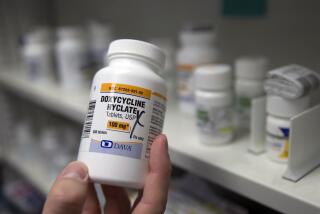Demographics of AIDS Shifting in the United States
- Share via
BARCELONA, Spain — AIDS in the United States has changed dramatically in the last decade, from an epidemic afflicting primarily gay and drug-using white men to a scourge of the African American community, participants in the 14th International AIDS Conference were told Sunday.
About 15,000 scientists, educators, journalists and people living with AIDS have gathered in this Mediterranean port city for the weeklong conference, making it the largest such gathering ever.
Addressing the opening session, Dr. Ronald Valdiserri of the Centers for Disease Control and Prevention said the number of new HIV infections in the U.S. has remained relatively constant, at about 40,000 a year since 1998. HIV is the virus that causes the AIDS disease. But that apparent stability, he said, is masking a “slow but steady increase” in the number of gay black men and heterosexual black women who are contracting the disease.
Fully 75% of all new HIV infections of heterosexuals in the U.S. occur among African Americans, a “hugely disproportionate” number considering that blacks represent only 12% of the U.S. population, Valdiserri said.
But the new data could be misleading, he cautioned. CDC figures are based on data from 25 states where HIV infection reporting by name has gone on for several years. But those states account for only an estimated one-quarter of new HIV infections.
They also do not include California, Florida and New York, which are not only hotbeds of high-risk sexual behavior but also home to much greater populations of blacks and Latinos, who are now bearing the brunt of the epidemic.
“We are very concerned that increases [in the HIV infection rate] are just around the corner,” he said.
According to the new CDC data, as of June 2001, 793,026 AIDS cases had been recorded in the United States since the epidemic began two decades ago, with 457,667 deaths. The agency estimates that 850,000 Americans are living with an HIV infection but that as many as half of them are undiagnosed, untreated or both.
Although incomplete, the data from the 25 states provide a “snapshot” of the AIDS epidemic today that can help in designing new prevention programs, Valdiserri said:
* Seven out of every 10 new victims of the virus are men.
* Men who have sex with men represent 42% of the new cases, heterosexuals of both sexes represent 33%, and injection-drug users 25%.
* African Americans account for 54% of new infections, Caucasians for 26%, Latinos 19% and others 1%. Like blacks, Latinos, who make up less than 13% of the U.S. population, are disproportionately affected.
Recognizing the limitations of the data from only 25 states, CDC is organizing a new national system to more accurately estimate the incidence of new infections. The program is being tested at five sites and will be expanded nationally next year, Valdiserri said.
The new data also showed that two-thirds of HIV-positive individuals in the U.S. are sexually active and that, among those, 25% to 43%--depending on age and gender--practice unsafe sex at least part of the time.
Such numbers are potentially frightening, Valdiserri added, because new treatments mean that the number of HIV-positive people is continuing to grow, increasing the risk of transmission.
“We have to renew HIV prevention in the United States,” Valdiserri said. “We need to get back to the level of collaboration, commitment and concern that we saw in the first decade of the epidemic.”






